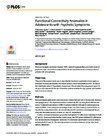| dc.contributor.creator | Higgins, Niamh | |
| dc.contributor.creator | Amico, Francesco | |
| dc.contributor.creator | O'Hanlon, Erik | |
| dc.contributor.creator | Kraft, Dominik | |
| dc.contributor.creator | Oertel-Knochel, Viola | |
| dc.contributor.creator | Clarke, Mary | |
| dc.contributor.creator | Kelleher, Ian | |
| dc.contributor.creator | Coughlan, Helen | |
| dc.contributor.creator | Creegan, Daniel | |
| dc.contributor.creator | Heneghan, Mark | |
| dc.contributor.creator | Power, Emmet | |
| dc.contributor.creator | Power, Lucy | |
| dc.contributor.creator | Ryan, Jessica | |
| dc.contributor.creator | Frodl, Thomas | |
| dc.contributor.creator | Cannon, Mary | |
| dc.date.accessioned | 2019-01-21T11:13:13Z | |
| dc.date.available | 2019-01-21T11:13:13Z | |
| dc.date.issued | 2017 | |
| dc.identifier.citation | Amico F, O'Hanlon E, Kraft D, Oertel- KnoÈchel V, Clarke M, Kelleher I, et al. (2017) Functional Connectivity Anomalies in Adolescents with Psychotic Symptoms. PLoS ONE 12(1): e0169364. doi:10.1371/journal.pone.0169364. | en_US |
| dc.identifier.uri | http://hdl.handle.net/10395/2579 | |
| dc.description | Functional connectivity anomalies in adolescents with psychotic symptoms. | en_US |
| dc.description.abstract | Background
Previous magnetic resonance imaging (MRI) research suggests that, prior to the onset of psychosis, high risk youths already exhibit brain abnormalities similar to those present in patients with schizophrenia.
Objectives
The goal of the present study was to describe the functional organization of endogenous activation in young adolescents who report auditory verbal hallucinations (AVH) in view of the ªdistributed networkº hypothesis of psychosis. We recruited 20 young people aged 13± 16 years who reported AVHs and 20 healthy controls matched for age, gender and handedness from local schools.
Methods
Each participant underwent a semi-structured clinical interview and a resting state (RS) neuroimaging protocol. We explored functional connectivity (FC) involving three different networks: 1) default mode network (DMN) 2) salience network (SN) and 3) central executive network (CEN). In line with previous findings on the role of the auditory cortex in AVHs as reported by young adolescents, we also investigated FC anomalies involving both the primary and secondary auditory cortices (A1 and A2, respectively). Further, we explored between-group inter-hemispheric FC differences (laterality) for both A1 and A2. Compared to the healthy control group, the AVH group exhibited FC differences in all three networks investigated. Moreover, FC anomalies were found in a neural network including both A1 and A2. The laterality analysis revealed no between-group, inter-hemispheric
differences.
Conclusions
The present study suggests that young adolescents with subclinical psychotic symptoms exhibit functional connectivity anomalies directly and indirectly involving the DMN, SN, CEN and also a neural network including both primary and secondary auditory cortical regions. | en_US |
| dc.language.iso | eng | en_US |
| dc.publisher | Public Library of Science | en_US |
| dc.relation.ispartofseries | 12;1 | |
| dc.rights.uri | https://doi.org/10.1371/journal.pone.0169364 | en_US |
| dc.subject | Functional connectivity | en_US |
| dc.subject | Anomalies | en_US |
| dc.subject | Adolescents | en_US |
| dc.subject | Psychotic symptoms | en_US |
| dc.title | Functional connectivity anomalies in adolescents with psychotic symptoms | en_US |
| dc.type | Article | en_US |
| dc.type.supercollection | all_mic_research | en_US |
| dc.type.supercollection | mic_published_reviewed | en_US |
| dc.description.version | Yes | en_US |
| dc.identifier.doi | 10.1371/journal.pone.0169364 | |


